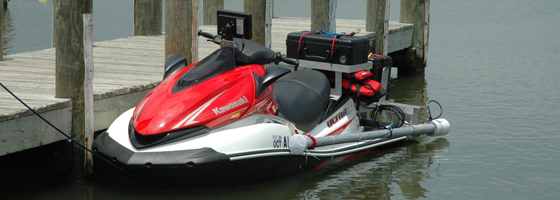Engineer transforms Jet Ski into water monitoring machine

Bret Webb had a plan: outfit a Jet Ski with equipment capable of mapping underwater coastal topography in Alabama’s Mobile Bay. He called it the Jag Ski.But the plan changed in the spring of 2010, when the Deepwater Horizon drilling rig exploded and unleashed the biggest oil spill in U.S. history on the Gulf of Mexico.
Webb, an assistant professor of civil engineering at University of South Alabama, wanted a personal watercraft that could conduct bathymetric surveys in shallow coastal waters inaccessible to the larger vessels ordinarily equipped for that kind of measurement. He outfitted a 2008 Kawasaki Ultra Lx with an acoustic Doppler current profiler capable of both bathymetric surveys and current profiling.
“It was really going to stop there, and then the oil spill happened,” Webb said.
Water from the Gulf feeds into Mobile Bay, which is right in the university’s back yard. Webb knew he had to add water quality monitoring capability to his creation.
He equipped the personal watercraft with a YSI Portable SeaKeeper, tailored to fit the personal watercraft. He used the custom-built, compact unit in concert with a Turner Designs fluorometer, which measures hydrocarbons in water.
The YSI team created a special ram intake so that water would flow to the monitoring equipment at any speed. A water pump keeps water pressure stably feeding sensors. A weather monitoring station supplements surface water data.

Named for the University of Southern Alabama’s Jaguars mascot, the Jag Ski had its first major mission in 2010. Five years earlier, Hurricane Katrina cut a channel through a barrier island at the mouth of Mobile Bay. After the Gulf spill, the BP officials sugggested filling the breach to block oil from flowing through and into the bay.
Webb saw a research opportunity. Breaches usually close up over time, he said, but this one remained for years. Intrigued, he took the Jag Ski through the breach and found that the depth was irregular and water recirculated, but mainly flowed seaward. He learned there was too little sand in the area to close the breach naturally.
Later, Webb used the Jag Ski out monitor shipping channels in Mobile Bay, where he found that the channel affected tidal mixing and speed.
The equipment’s surface water quality monitoring chops were tested on the Dog River, which contributes fresh water to the Mobile Bay. Sensors showed that hydrocarbons increased near marinas and boat ramps.
Webb tested the SeaKeeper at a reservoir that provides drinking water to Mobile. There he deduced that the Jag Ski’s speed only affected readings of turbidity and dissolved oxygen sensors.
Webb spent three months searching for the best personal watercraft to transform into a water monitoring vehicle. It had to handle the weight of the monitoring technology and needed a layout for attaching the equipment without drilling any holes.
A 2008 Kawasaki Ultra Lx three-person watercraft was the most ideal platform. The large 160 horsepower watercraft easily handled the extra weight of monitoring equipment, which Webb and his team attached with built-in fasteners and clamps.
Before modification, the watercraft’s top speed was 60 miles per hour. After 200 pounds of monitoring technology was attached, it still can reach 48 miles per hour, Web said. It burns 24 gallons of fuel in 10 hours at moderate, consistent speeds.
While the Jag Ski has worked well for Webb, there are a few disadvantages. It does not have the range or protection of larger vessels. It also has a smaller carrying capacity, which Webb says is now at its limit.
Limiting factors do force the surveyor to take a break and return to shore if inclement weather is on the horizon, but that’s a good thing, Webb said.
Still, Webb said the personal watercraft platform was ideal for surveying coastal areas and surf zones. “It’s maneuverable and it’s agile, and if it flips you can just turn it back over and keep going,” he said.
For the record, he said he’s only flipped it once during testing. Though he was nervous, everything fared well.
Top image: The Jag Ski docked at Dauphin Island (Credit: Brett Webb)




0 comments